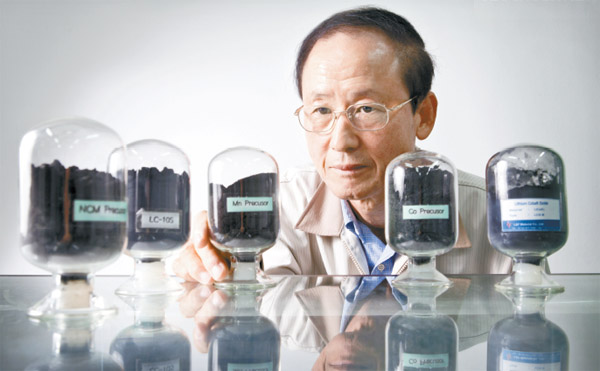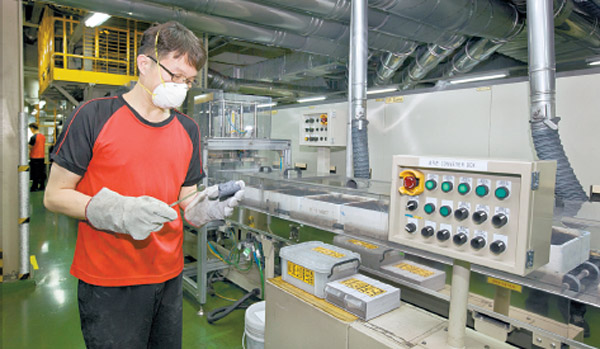L&F Material charges ahead in secondary batteries

Lee Bong-won, CEO of L&F Material, oversees the company’s signature cathode materials at the factory in Chilgok County, North Gyeongsang. By Park Sang-moon
A small battery material developer based in the village of Waegwan, Chilgok County, North Gyeongsang, is at the core of the success.

product quality manager at L&F Material’s factory in Waegwan, Chilgok County, North Gyeongsang, inspects cathode materials as they come off the assembly line. By Park Sang-moon
In Korea, where R&D is still a cost hurdle for small and midsize companies, L&F Material also has its own R&D center where almost 20 percent of its employees work. The company now operates three production facilities, one at the Waegwan headquarters and two in Daegu.
The leadership and decision-making of CEO Lee Bong-won were essential for such quick growth.
Both the company and Lee started with no background in battery materials in 2005. The mother company L&F was in the LCD panel backlight business and decided to establish an affiliate to explore secondary batteries. Lee had spent most of his career in aluminum manufacturing.
In 2005, the secondary battery industry barely existed in Korea. Secondary batteries are rechargeable and usually used to store power for electronic devices like cell phones and laptops.
Demand for secondary batteries wasn’t high before IT devices dominated people’s lives.
And Samsung SDI and LG Chem were in the early stages of their battery businesses, importing technology and materials from traditionally strong battery nations like Japan.
Lee immediately started recruiting battery and materials experts.
One tool to attract talent was stock options, which even now is not common in Korea.
“Ten years ago, we couldn’t give large sums of money, but this definitely was an efficient tool when persuading technology experts and industry workers,” said Lee, “because this policy gets employees to think they are owners of this company, making it part of their lives. Our company is a success that we nurtured together.”
As company growth skyrocketed after 2007, stock options acted as a motivator. The company only grants stock options to a handful of employees in proportion to their level of contribution. He sees giving back to employees as not only a benefit, but an alternative form of investment.
“My career started as a regular employee at a midsize company, so I totally understand their minds,” said Lee. “Throughout my career, I always wondered why the company didn’t compensate employees enough, even when the company sees its profit going up.
“I thought a company should give back to the employees, whether it is a financial incentive or an academic opportunity for their career development.”
After L&F Material opened its research center in 2007, the company received technology mentoring from Japanese engineers and had joint projects with the top-tier companies for which they worked.
In the early years, the R&D center mainly researched accelerating the commercialization of technologies for small batteries for mobile phones. The company focused on cathode material, which makes up 33.5 percent of a secondary battery.
Before the company tackled it, cobalt was the most common ingredient in cathode material.
After years of research, L&F Material succeeded in developing a nickel-cobalt-manganese (NCM) material manufacturing technology available locally. This opened doors at major customers like LG Chem and Samsung SDI.
In 2012, the company exported its NCM to Japan.
“The first export to Japan was one of the most meaningful moments for us, because in the past, Japan considered itself as the ‘suzerain of battery and battery material,’ producing global battery makers like Sony and Sanyo,” Lee said. “Since the country had very sturdy industry, it wasn’t so easy to enter the market by appealing to them with our own original material.”
Recently, it started developing materials for midsize and large batteries in response to worldwide demand for electric cars and ESS facilities.
The company invested about 5 percent of its annual sales in R&D as of the first half of this year, and it hopes to develop more original materials.
“Despite the fact that Chinese companies are behind us in terms of technology advancement, we shouldn’t relax,” said Lee. “Chinese companies are pressing us with price competitiveness, which is possible due to the government’s heavy subsidies.
“Japan is no different. Japan is still technologically advanced, and its government still backs its battery industry in the same way as the Chinese government,” Lee added.
Lee explained more about his company’s relationship with China, one of L&F Material’s largest overseas customers. And the company has a cooperative company there.
“Even though Chinese companies are strong competitors, the country will remain our customer, in particular in small batteries, because of the massive market thee for portable electronic devices,” he said.
Other significant markets are Europe and the United States, which mostly demand midsize and large batteries for electric car and ESS developers.
“Currently, the world battery market is roughly shared by three East Asian countries: Korea with 40 percent, and Japan and China each with 30 percent,” Lee explained. “The industry was structured like this mainly because of the IT and mobile industries’ explosive growth.
“However, the next destination for us is the United States and Europe, where we will offer materials customized for those bigger batteries. Development of electric cars and ESS is our opportunity to tap larger markets.”
Lee said he will continuously emphasize R&D because it will be essential when L&F Material has to meet those market needs in the future.
“There are more companies in Daegu and North Gyeongsang that generate sales larger than us in multtrillion won range.” said Lee. “But the only thing small companies like us [in rural regions] lack is quality talent,” he said. “Of course, we already have great talent, but the problem is that not many people are eager to work in rural areas.”
So far, the company has run talent fostering and exchange programs with universities in the region and prestigious universities, like Seoul National University and Kaist,in other parts of the country.
Lee said the government should push harder for balanced regional development so top-tier talent will consider rural-based companies if life and industrial infrastructure is well developed.
“Who would choose to a rural village instead of Seoul-based conglomerates and Gyeonggi?” said Lee. “Even though we are doing some talent exchanges, that’s not enough just because there are only a limited amount of new material graduates. Seoul universities teach this area, but most graduates will hope to work in Seoul, while it is hard to find universities outside Seoul that teach this area.”
CEO’s profile
* Bachelor’s degree in business from Yeungnam University and master’s degree in business administration from Kyungpook National University
* Passed tax accountant license exam in 1975
* Worked at Namsun Aluminum, L&F Corporation
* Vice president of Korea Battery Industry Association
Company fact sheet
* CEO: Lee Bong-won
* Established: 2005
* Employees: 178
* Plants: Three (one in Chilgok and two in Daegu)
* Products: Cathode active materials for lithium ion secondary batteries
* Buyers: Samsung SDI, LG Chem and electric vehicle battery manufacturers based in Japan, North America and Europe
BY KIM JI-YOON [jiyoon.kim@joongang.co.kr]










with the Korea JoongAng Daily
To write comments, please log in to one of the accounts.
Standards Board Policy (0/250자)